Linda Carles
Physical characteristics and aquatic settlement properties of offshore drill-cuttings.
Carles, Linda
Authors
Contributors
Shelley Naik
Supervisor
Ian Bryden
Supervisor
Babs Oyeneyin
Supervisor
Abstract
Drilling operations have been proven to cause pollution in the marine environment. From these environmental concerns, regulations and drilling muds evolved towards more environmental orientated operations. The environmental impact assessment is now compulsory and made public. In order to carry out some aspects of this assessment, environmental engineers run models for the prediction of the wastes dispersion into the sea. The existing models have been studied and two main points were observed: the required input data on cuttings characteristics was not available for specific drilling conditions, and; the settling properties of the particles was not adapted to the type of modelled particles. There was no readily available information about correlations between the cuttings size and the drilling parameters. Moreover, there was no study on the settlement of cuttings made on a large number of real drill-cuttings. From these observations, it was clear that the cuttings characteristics needed to be studied under different drilling conditions. The aquatic settlement properties of the cuttings also became a focus of the present study. A spontaneous and long-term enthusiasm from the oil industry made the study possible. The collection of samples and data was then carried out prior to laboratory experiments. From these experiments, the characteristics (i.e. size and shape) of cuttings were defined as well as the cuttings settling speeds. The new data on settling speeds was then analysed by comparison with other experimental works, correlations for settling speeds and drag correlations. Computational work also confirmed the need for a better adapted drag correlation. Therefore, based on the experimental data, a new drag correlation was determined. It is believed to be valid for cuttings of any shape for Reynolds number up to 1000. The cuttings size distributions drawn from experiments were also analysed using a commercial statistical package. From this analysis, new correlations between the cuttings size and the drilling parameters were defined. The quality, robustness and limitations of these correlations are discussed. Each model was carefully assessed and improved until satisfaction. A Fortran 90 program was then written to support the database. The program asks for input data from the user and returns the cuttings size distributions as output data. It interpolates incoherent data and advises the user to change the combination when required. It also gives information about the new drag correlation and average sphericity for drill-cuttings. The present work contributes to the knowledge of physical characteristics and aquatic settlement properties of offshore drill-cuttings. It is based only on offshore samples and data which makes its originality. There are many applications of the findings both in the drilling and environmental engineering. Some of the findings have already been incorporated in commercial software for environmental consultancy. Nevertheless, there is place for further work on this fascinating subject. Recommendations are made, based on ranging experiments and criticism of the present work.
Citation
CARLES, L. 2000. Physical characteristics and aquatic settlement properties of offshore drill-cuttings. Robert Gordon University, PhD thesis. Hosted on OpenAIR [online]. Available from: https://doi.org/10.48526/rgu-wt-2807321
| Thesis Type | Thesis |
|---|---|
| Deposit Date | Jun 23, 2025 |
| Publicly Available Date | Jun 23, 2025 |
| DOI | https://doi.org/10.48526/rgu-wt-2807321 |
| Public URL | https://rgu-repository.worktribe.com/output/2807321 |
| Award Date | Feb 29, 2000 |
Files
CARLES 2000 Physical characteristics and aquatic
(56 Mb)
PDF
Licence
https://creativecommons.org/licenses/by-nc/4.0/
Copyright Statement
© The Author.
Downloadable Citations
About OpenAIR@RGU
Administrator e-mail: publications@rgu.ac.uk
This application uses the following open-source libraries:
SheetJS Community Edition
Apache License Version 2.0 (http://www.apache.org/licenses/)
PDF.js
Apache License Version 2.0 (http://www.apache.org/licenses/)
Font Awesome
SIL OFL 1.1 (http://scripts.sil.org/OFL)
MIT License (http://opensource.org/licenses/mit-license.html)
CC BY 3.0 ( http://creativecommons.org/licenses/by/3.0/)
Powered by Worktribe © 2025
Advanced Search
